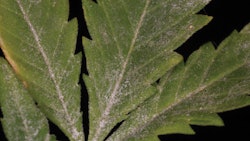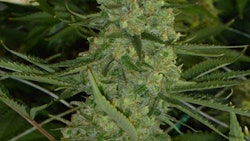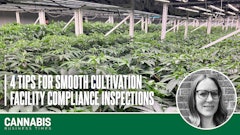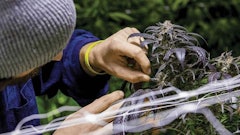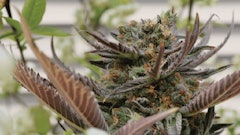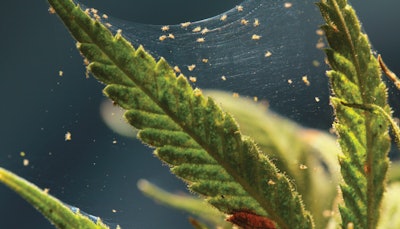
The gauntlet is a trial requiring fleetness of foot and quickness of wit to avoid the worst punishment the course may bring, and pest management is a gauntlet of challenges, each with the ability to raise havoc in the corner office.
Nothing will focus the mind more than a powdery mildew (PM) or botrytis outbreak in week 7 of flower, so the lesson is not to wait for that to happen. Start on day 1. Even better, start before day 1, and plan how you intend to control pests—all of them —whenever and wherever they may strike. Build your primary plan around prevention, and make sure you have a plan B for when the pests get through those defenses because plan C is limiting losses.
Successful pest management is based on understanding the options available. Make sure your entire team is knowledgeable about identifying pests, their life cycles, and their strengths and weaknesses. Follow that up with awareness of the various controls available and how they work. Add a maniacal focus on prevention, rapid detection and fast treatment, and you have the underpinnings of a successful pest management scheme.
Here are 14 tips to help you through the process of establishing and implementing an effective integrated pest management (IPM) strategy.
Prevention Is Your Best Defense
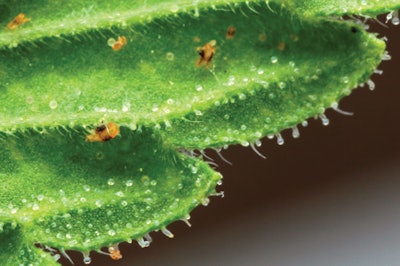
Mom and veg rooms are a great place to start talking about pest management because there are no flowers to worry about, and no state we know of forbids all pesticide use on veg plants. Even with the limited set of pesticides available to cannabis growers, you can prevent PM, spider mites, aphids, thrips and russet/broad mites. TIP: If you are having trouble in veg, spend more time scouting, rethink your choice of pesticides, add another pesticide to your rotation and use spot treatments between major spray events. There is nothing PM likes more than neglect, which gives it a chance to take off and ruin a perfectly good crop. Daily scouting and fast treatment is the prescription for PM and botrytis.
Botanic and highly refined petroleum oils are effective at controlling PM and soft-bodied pests. TIP: Avoid oils in flower to keep the extractors happy, but use them liberally on your moms, cuttings and veg. Use dilute oil solutions as a dip for cuttings just before they are stuck into the rooting cube, and use oil sprays for moms and veg plants. It’s difficult to make a mistake when there is only one pesticide being used. Resistance build-up is not a concern because the oils’ main mode of action is suffocation. If the oil label says it can be mixed with other pesticides, you may be able to get even more effective control.
Oils don’t work everywhere, however. As cuttings are typically tightly packed in root-out trays, it is difficult to get spray to the tender and tasty roots where it can make contact with and kill gnat larvae. The same is true of Azadirachtin. TIP: So an alternative is to call in ground troops to seek and destroy. The highly mobile predatory mite Hypoaspis (Stratiolaelaps scimitus) is effective at patrolling cuttings and keeping gnat populations down.
TIP: When you move to larger containers, you may find that Bacillus thuringiensis (Bti)-based products that disrupt feeding are a good alternative to predators. These can be distributed with fertigation water or added to media for a relatively easy way to control gnat populations within an operation’s vast sea of plants. TIP: Throw in an Azadirachtin drench into your scheme to add a contact-kill capability. TIP: Also, be sure to monitor your sticky traps, and increase or modify your treatments to cut down on “black with gnats” sticky card syndrome.
Keeping plants pest-free through veg is critical. Spraying anything (including water) in flower exposes buds to problems, and if you can reserve sprays for plan B or C, do it.
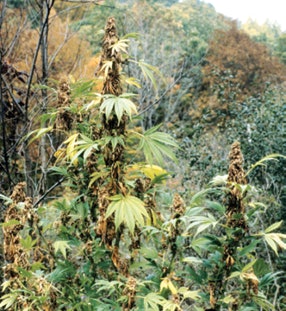
In states where no pesticides are allowed in flower, early detection and water may be the only tools a grower possesses to control both PM and insect pests.
TIP: If PM outbreaks can be spotted while they are small, isolation/removal policies and water sprays may be effective at disrupting the pests. Water also can disrupt spider mites that like hot and dry conditions. TIP: Disruption is not eradication, so once discovered, the grower must monitor pest populations daily and use water sprays as needed to keep the populations under control. Try to minimize spray on the flowers if you can, but don’t be too shy—just get them dry before dark.
After adding predatory mites and insects, including parasitic wasps, the biggest problem that will remain is PM. Unfortunately, predators that control PM are not proven on the type of PM we find on cannabis—according to “Suppression of Grapevine Powdery Mildew by a Mycophagous Mite,” written by Cornell University plant pathologists and entomologists—so spraying may not be totally avoidable.
But fewer spray events throughout the growth cycle may make the difference in whether a crop gets botrytis or not.
So don’t get too smug with your ability to control PM because botrytis is in the air waiting to turn your buds into trash. The sad truth is that no treatment is available to reverse a botrytis infestation. Instead, you may be faced with limiting losses by removing affected buds and plants. TIP: Once botrytis has been found in the flower room, make sure your trim team carefully screens the harvest.
If You Must Spray …
TIP: If you are allowed to use pesticides against PM in flower, life may be a bit easier, but we recommend sticking with mineral and biologically based products in flower. Many of those are certified by the Organic Materials Review Institute (OMRI), so if any residuals are left on the product, there is a good chance the consumer ate food for lunch that has the same residuals on it. Potassium bicarbonate is one mineral-based product that may burn your pretty pistils, but will save your crop in the process.
TIP: Biological products commonly approved for use in fighting PM include Bacillus subtilis, which is on almost every legal state’s list of pesticides approved for cannabis cultivation. But other effective biological ingredients like Reynoutria sachalinensis, Trichoderma harzianum, Ampelomyces quisqualis and Streptomyces lydicus are not approved in all states. Don’t get busted for unapproved pesticides; check state rules before purchasing and applying any pesticide.
Don’t forget your roots. Pythium and fusarium pathogens kill plants quickly, and if pathogens can be carried from one plant to another by water (as in ebb-and-flow systems), large numbers of plants can be affected. TIP: In hydroponic systems, use hydrogen peroxide and other pathogen-killing products in the nutrient solution. TIP: In media-based systems, mycorrhizal fungus not only will colonize roots (providing a boost to the plant’s nutrient uptake), but will also form a protective barrier against root diseases. Trichoderma harzianum-based products also form a protective barrier on roots.
Problems Beneath the Surface
Of course, there is the hidden enemy within. Cannabis has been found to harbor bacteria that has no obvious outward symptoms, but does make it impossible to propagate the plants through tissue culture as the bacteria grows so aggressively in the tissue culture agar. TIP: Reports of mysterious changes in growth habit might be due to systemic issues, and for these, onsite tests—specifically enzyme-linked immunosorbent assays (ELISAs)—and an in-state microbiological lab that will accept cannabis tissue can help you determine whether your plants are harboring systemic viruses, bacteria or fungal pathogens. If not, it’s time to look outside the plant for the cause. Take heart though: As of this writing, we have yet to see a positive test result for viruses in cannabis.
If it were as simple as doing any or all of the things we have noted here, life would be good. But the reality is that a control program that works today may need to be tweaked from time to time. You may find generalist predators are not as effective as multiple specialist predators, or maybe the environment was not conducive to the predator currently being released. Perhaps a combination of treatments would be more effective than using a single one, and you might even find instituting a different worker-access policy cuts down on pests to the point that a treatment that did not work yesterday is now effective against reduced pest populations.
Pest management is a journey. There are many twists and turns in the IPM process, and the savvy grower may find a little paranoia coupled with increased scouting can help prevent major losses. Whatever the issue, the goal is to keep the plants healthy and to get them to harvest with as few losses as possible. Teams that are both knowledgeable and light on their feet have the best chance of succeeding in running the gauntlet.









